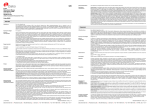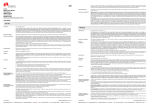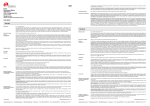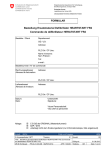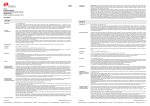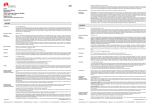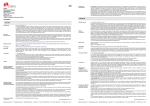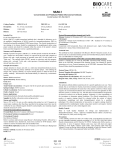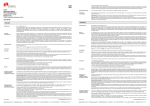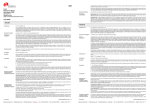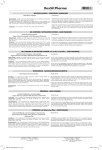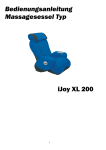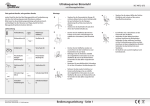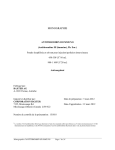Download FLEX Monoclonal Mouse Anti-Human CD138 Clone MI15
Transcript
Counterstaining in hematoxylin is recommended using EnVision FLEX Hematoxylin, (Dako Autostainer/Autostainer Plus) (Code K8018). Non-aqueous, permanent mounting medium is recommended. Positive and negative controls should be run simultaneously using the same protocol as the patient specimens. The positive control tissue should include tonsil and the cells/structures should display reaction patterns as described for this tissue in “Performance characteristics” in all positive specimens. The recommended negative control reagent is FLEX Negative Control, Mouse, (Dako Autostainer/Autostainer Plus) (Code IS750). FLEX Monoclonal Mouse Anti-Human CD138 Clone MI15 Ready-to-Use (Dako Autostainer/Autostainer Plus) Staining interpretation Cells labeled by the antibody display membrane staining. Performance characteristics Normal tissues: In tonsil, the plasma cells show a moderate to strong staining reaction, whereas the epithelial cells show a weak to moderate staining reaction. No significant reaction is seen with leucocytes from normal peripheral human blood (< 5%) and no significant reaction is seen in normal bone marrow (< 5%). CD138 labeling is absent from CD34-positive stem cells (1). Abnormal tissues: In bone marrow from multiple myeloma patients, all plasma cell types are labeled, including reticular, polymorphous, asynchronous and blastic plasma cells (2). Code IS642 FRANÇAIS ENGLISH Pour utilisation lors d’un diagnostic in vitro. Utilisation prévue For in vitro diagnostic use. Intended use FLEX Monoclonal Mouse Anti-Human CD138, Clone MI15, Ready-to-Use (Dako Autostainer/Autostainer Plus), is intended for use in immunohistochemistry together with Dako Autostainer/Autostainer Plus instruments. This antibody is useful for the identification of malignancies involving terminally differentiated plasma cells, and it is associated with multiple myeloma (1, 2). Antibodies to CD138 may also be useful for the subclassification of diffuse large B-cell lymphoma (3). The clinical interpretation of any staining or its absence should be complemented by morphological studies using proper controls and should be evaluated within the context of the patient's clinical history and other diagnostic tests by a qualified pathologist. Synonym for antigen Syndecan-1 (1). Summary and explanation CD138 is a transmembrane proteoglycan, bearing heparan sulfates and sometimes chondroitin sulfates. It consists of a 30.5 kDa core protein and five glycosaminoglycans. CD138 is a member of the syndecan family. The reported Mr of CD138 ranges from 85 000 to 92 000, presumably depending on the glycosaminoglycan pattern of the molecule (1). FLEX Monoclonal Mouse Anti-Human CD138, Clone MI15, Ready-to-Use (Dako Autostainer/Autostainer Plus), est destiné à une utilisation en immunohistochimie avec les instruments Dako Autostainer/Autostainer Plus. Cet anticorps permet l'identification de tumeurs malignes impliquant les cellules plasmatiques en stade de différenciation terminale, et il est associé à de multiples myélomes (1, 2). Les anticorps au CD138 permettent aussi la sous-classification des lymphomes diffus à grands lymphocytes B (3). L’interprétation clinique de toute coloration ou son absence doit être complétée par des études morphologiques en utilisant des contrôles appropriés et doit être évaluée en fonction des antécédents cliniques du patient et d’autres tests diagnostiques par un pathologiste qualifié Synonyme de l’antigène Syndecan-1 (1). Résumé et explication Le CD138 est un protéglycane transmembranaire, portant des héparane-sulfates et parfois des chondroïtine-sulfates. Il consiste en une protéine de noyau de 30,5 kDa et cinq glycosaminoglycanes. Le CD138 fait partie de la famille des syndécanes. Le poids moléculaire rapporté pour le CD138 varie entre 85 000 et 92 000, probablement en fonction de la forme glycosaminoglycane de la molécule (1). Au sein du système hématopoïétique, le CD138 est surtout confiné aux stades tardifs de la différenciation des lymphocytes B. Il s'exprime normalement à une densité cellulaire élevée dans les cellules plasmatiques normales et malignes (4, 5) et dans les cellules lymphoplasmocytoïdes (4). Dans les tissus matures, le CD138 s'exprime dans les épithéliums simples et stratifiés, les fibroblastes, les kératinocytes stratifiés et les cellules endothéliales (1). Within the haematopoietic system, CD138 is mainly confined to late stages of B-cell differentiation. It is typically expressed at high cellular density in normal and malignant plasma cells (4, 5) and in lymphoplasmocytoid cells (4). In mature tissue CD138 is expressed by simple and stratified epithelia, fibroblasts, stratified keratinocytes and endothelial cells (1). CD138 expression is reduced during malignant transformation of various epithelia (7), and the antigen is rapidly lost (shed) by myeloma cells entering into apoptosis, thus CD138 is a marker of viable myeloma cells (1, 6). CD138 is lost upon malignization of several stratified epithelia (7). Together with anti-BCL-6 and anti-IRF4, anti-CD138 may be of value for the diagnosis of AIDS-related non-Hodgkin lymphomas and HIV-related Hodgkin lymphomas (8). Additionally, antiCD138 may aid in the subclassification of diffuse large B-cell lymphoma together with anti-CD10, anti-BCL-6 and anti-MUM1 (3). La fonction du CD138 est encore inconnue pour sa plus grande part. Toutefois, la queue intracellulaire du CD138 semble se fixer au cytosquelette par des composants cellulaires (1), et la partie extracellulaire de la molécule semble se lier à des ligands différents. Le CD138 joue probablement un rôle dans les fonctions cellulaires, comme la prolifération, la mort programmée de la cellule, la matrice cellulaire et l'adhésion entre les cellules (5), par exemple il est le médiateur de l'adhésion des cellules de myélomes au collagène de type I (6). L'expression du CD138 est réduite durant la transformation tumorale de divers épithéliums (7), et l'antigène est rapidement perdu (divisé) par les cellules de myélomes entrant en apoptose, et donc le CD138 est un marqueur des cellules de myélomes viables (1, 6). Le CD138 est perdu au moment de la dégénérescence en tissu tumoral de plusieurs épithéliums stratifiés (7). Avec l'anti-BCL-6 et l'anti-IRF4, l'anti-CD138 peut être précieux pour le diagnostic des lymphomes non hodgkiniens associés au SIDA, et aux lymphomes hodgkiniens liés au VIH (8). De plus, l'anti-CD138 peut aider à la sous-classification de lymphomes diffus à grands lymphocytes B, utilisé conjointement aux anti-CD10, anti-BCL-6 et anti- MUM1 (3). Refer to Dako’s General Instructions for Immunohistochemical Staining or the detection system instructions of IHC procedures for: 1) Principle of Procedure, 2) Materials Required, Not Supplied, 3) Storage, 4) Specimen Preparation, 5) Staining Procedure, 6) Quality Control, 7) Troubleshooting, 8) Interpretation of Staining, 9) General Limitations. Se référer aux Instructions générales de coloration immunohistochimique de Dako ou aux instructions du système de détection relatives aux procédures IHC pour plus d’informations concernant les points suivants : 1) Principe de procédure, 2) Matériels requis mais non fournis, 3) Conservation, 4) Préparation des échantillons, 5) Procédure de coloration, 6) Contrôle qualité, 7) Dépannage, 8) Interprétation de la coloration, 9) Limites générales. The function of CD138 is largely unknown. However, the intracellular tail of CD138 seems to bind together the cytoskeleton with cellular components (1), and the extracellular part of the molecule seems to bind different ligands. Presumably, CD138 plays a role in cellular functions, such as proliferation, programmed cell death, cellmatrix and cell-cell adhesion (5), for example it mediates adhesion of myeloma cells to type I collagen (6). Ready-to-use monoclonal mouse antibody provided in liquid form in a buffer containing stabilizing protein and 0.015 mol/L sodium azide. Reagent provided Anticorps monoclonal de souris prêt à l’emploi, fourni sous forme liquide dans un tampon contenant une protéine stabilisante et 0,015 mol/L d’azide de sodium. Réactifs fournis Clone: MI15. Isotype: IgG1, kappa. Clone : MI15. Isotype : IgG1, kappa. Immunogen A mixture of U266 and XG-1 human myeloma cell lines (2, 9). Immunogène Un mélange de lignées cellulaires de myélome humain U266 et XG-1 (2, 9). Specificity Anti-Human CD138, clone MI15, was clustered as anti-CD138 at the 6th International Workshop and Conference on Human Leucocyte Differentiation Antigens (1). Spécificité Anti-Human CD138, clone MI15, a été classé comme un anti-CD138 à la 6th International Workshop and Conference on Human Leucocyte Differentiation Antigens (6e Conférence et Atelier Internationaux sur les Antigènes de Différenciation des Leucocytes Humains) (1). The epitope recognized by anti-CD138, MI15, is found within the ectodomain (extracellular part) of the CD138 core protein. Blocking experiments have revealed that the epitope recognized by MI15 seems to be partly overlapping the epitope recognized by another antibody to CD138, clone B-B4 (1, 5). Anti-CD138, MI15, reacts strongly with CD138 expressed by multiple myeloma-derived cell lines, such as U266 and XG-1 (9). 1. For professional users. 2. This product contains sodium azide (NaN3), a chemical highly toxic in pure form. At product concentrations, though not classified as hazardous, sodium azide may react with lead and copper plumbing to form highly explosive build-ups of metal azides. Upon disposal, flush with large volumes of water to prevent metal azide build-up in plumbing. 3. As with any product derived from biological sources, proper handling procedures should be used. 4. Wear appropriate Personal Protective Equipment to avoid contact with eyes and skin. 5. Unused solution should be disposed of according to local, State and Federal regulations. Precautions Store at 2-8 °C. Do not use after expiration date sta mped on vial. If reagents are stored under any conditions other than those specified, the conditions must be verified by the user. There are no obvious signs to indicate instability of this product. Therefore, positive and negative controls should be run simultaneously with patient specimens. If unexpected staining is observed which cannot be explained by variations in laboratory procedures and a problem with the antibody is suspected, contact Dako Technical Support. Storage Specimen preparation including materials required but not supplied L'épitope reconnu par l'anti-CD138, MI15, se trouve dans l'ectodomaine (partie extracellulaire) de la protéine de noyau du CD138. Les expériences de blocage ont révélé que l'épitope reconnu par le MI15 semble chevaucher en partie l'épitope reconnu par un autre anticorps du CD138, le clone B-B4 (1, 5). L'anti-CD138, MI15, réagit fortement avec le CD138 exprimé par de multiples lignées cellulaires dérivées de myélomes, comme les lignées U266 et XG-1 (9). Précautions 1. Pour utilisateurs professionnels. 2. Ce produit contient de l’azide de sodium (NaN3), produit chimique hautement toxique dans sa forme pure. Aux concentrations du produit, bien que non classé comme dangereux, l’azide de sodium peut réagir avec le cuivre et le plomb des canalisations et former des accumulations d’azides métalliques hautement explosifs. Lors de l’élimination, rincer abondamment à l’eau pour éviter toute accumulation d’azide métallique dans les canalisations. 3. Comme avec tout produit d’origine biologique, des procédures de manipulation appropriées doivent être respectées. 4. Porter un vêtement de protection approprié pour éviter le contact avec les yeux et la peau. 5. Les solutions non utilisées doivent être éliminées conformément aux réglementations locales et nationales. Conservation Conserver entre 2 et 8 °C. Ne pas utiliser après la date de péremption indiquée sur le flacon. Si les réactifs sont conservés dans des conditions autres que celles indiquées, celles-ci doivent être validées par l’utilisateur. Il n’y a aucun signe évident indiquant l’instabilité de ce produit. Par conséquent, des contrôles positifs et négatifs doivent être testés en même temps que les échantillons de patient. Si une coloration inattendue est observée, qui ne peut être expliquée par un changement des procédures du laboratoire, et en cas de suspicion d’un problème lié à l’anticorps, contacter l’assistance technique de Dako. Préparation des échantillons y compris le matériel requis mais non fourni L’anticorps peut être utilisé pour le marquage des coupes de tissus inclus en paraffine et fixés au formol. L’épaisseur des coupes d’échantillons de tissu doit être d’environ 4 µm. The antibody can be used for labeling formalin-fixed, paraffin-embedded tissue sections. Tissue specimens should be cut into sections of approximately 4 µm. Pre-treatment with heat-induced epitope retrieval (HIER) is required. Optimal results are obtained by pretreating tissues using EnVision FLEX Target Retrieval Solution, High pH (10x), (Dako Autostainer/Autostainer Plus) (Code K8012/K8014). Deparaffinized sections: Pre-treatment of deparaffinized formalin-fixed, paraffin-embedded tissue sections is recommended using Dako PT Link (Code PT100/PT101). For details, please refer to the PT Link User Guide. Follow the pre-treatment procedure outlined in the package insert for EnVision FLEX Target Retrieval Solution, High pH (10x), (Dako Autostainer/Autostainer Plus) (Code K8012/K8014). The following parameters should be used for PT Link: Pre-heat temperature: 65 °C; epitope retrieval temperature and time: 97 °C for 2 0 (±1) minutes; cool down to 65 °C. Remove Autostainer sli de rack with slides from the PT Link tank and immediately dip slides into a jar/tank (e.g., PT Link Rinse Station, Code PT109) containing diluted room temperature EnVision FLEX Wash Buffer (10x), (Dako Autostainer/Autostainer Plus) (Code K8012). Leave slides in Wash Buffer for 1-5 minutes. Coupes déparaffinées : le pré-traitement des coupes de tissus déparaffinés fixés au formol et inclus en paraffine est recommandé à l’aide du Dako PT Link (Réf. PT100/PT101). Pour plus de détails, se référer au Guide d’utilisation du PT Link. Suivre la procédure de pré-traitement indiquée dans la notice pour la EnVision FLEX Target Retrieval Solution, High pH (10x), (Dako Autostainer/Autostainer Plus) (Réf. K8012/K8014). Les paramètres suivants doivent être utilisés pour le PT Link : température de préchauffage : 65 °C ; température et durée de restauration de l’épitope : 97 °C pendant 20 (±1) mi nutes ; refroidissement à 65 °C. Retirer le portoir à lames et les lames Autostainer de la cuve du PT Link et plonger immédiatement les lames dans un récipient/une cuve (p.ex., PT Link Rinse Station, réf. PT109) contenant du EnVision FLEX Wash Buffer (10x), (Dako Autostainer/Autostainer Plus) (Code K8012) dilué à température ambiante. Laisser les lames dans le Wash Buffer pendant 1–5 minutes. Paraffin-embedded sections: As alternative specimen preparation, both deparaffinization and epitope retrieval can be performed in the PT Link using a modified procedure. See the PT Link User Guide for instructions. After the staining procedure has been completed, the sections must be dehydrated, cleared and mounted using permanent mounting medium. Staining procedure including materials required but not supplied The tissue sections should not dry out during the treatment or during the following immunohistochemical staining procedure. For greater adherence of tissue sections to glass slides, the use of Dako Silanized Slides (Code S3003) is recommended. Coupes incluses en paraffine : comme préparation alternative des échantillons, le déparaffinage et la restauration de l’épitope peuvent être réalisés dans le PT Link à l’aide d’une procédure modifiée. Se référer aux instructions du Guide d’utilisation du PT Link. Une fois que la procédure de coloration est terminée, les coupes doivent être déshydratées, lavées et montées à l’aide d’un milieu de montage permanent. The recommended visualization system is EnVision FLEX+, Mouse, High pH, (Dako Autostainer/Autostainer Plus) (Code K8012). The staining steps and incubation times are pre-programmed into the software of Dako Autostainer/Autostainer Plus instruments, using the following protocols: Les coupes de tissus ne doivent pas sécher lors du traitement ni lors de la procédure de coloration immunohistochimique suivante. Pour une meilleure adhérence des coupes de tissus sur les lames de verre, il est recommandé d’utiliser des lames Dako Silanized Slides (Réf. S3003). Template protocol: FLEXRTU2 (200 µL dispense volume) or FLEXRTU3 (300 µL dispense volume) Autoprogram: CD138 (without counterstaining) or CD138H (with counterstaining) The Auxiliary step should be set to “rinse buffer” in staining runs with ≤10 slides. For staining runs with >10 slides the Auxiliary step should be set to “none”. This ascertains comparable wash times. Procédure de coloration y compris le matériel requis mais non fourni All incubation steps should be performed at room temperature. For details, please refer to the Operator’s Manual for the dedicated instrument. If the protocols are not available on the used Dako Autostainer instrument, please contact Dako Technical Services. Optimal conditions may vary depending on specimen and preparation methods, and should be determined by each individual laboratory. If the evaluating pathologist should desire a different staining intensity, a Dako Application Specialist/Technical Service Specialist can be contacted for information on reprogramming of the protocol. Verify that the performance of the adjusted protocol is still valid by evaluating that the staining pattern is identical to the staining pattern described in “Performance characteristics”. (117500-002) Dako Denmark A/S Le prétraitement avec un démasquage d’épitope induit par la chaleur (HIER) est nécessaire. Des résultats optimaux sont obtenus en prétraitant les tissus à l’aide de la EnVision FLEX Target Retrieval Solution, High pH (10x), (Dako Autostainer/Autostainer Plus) (Réf. K8012/K8014). IS642/EFG/SSM/07.04.08 p. 1/4 | Produktionsvej 42 | DK-2600 Glostrup | Denmark | Tel. +45 44 85 95 00 | Fax +45 44 85 95 95 | CVR No. 33 21 13 17 Le système de visualisation recommandé est le EnVision FLEX+, Mouse, High pH, (Dako Autostainer/Autostainer Plus) (Réf. K8012). Les étapes de coloration et les temps d’incubation sont préprogrammés dans le logiciel des instruments Dako Autostainer/Autostainer Plus, à l’aide des protocoles suivants : Protocole modèle : FLEXRTU2 (volume d’application de 200 µL) ou FLEXRTU3 (volume d’application de 300 µL) Programme automatique : CD138 (sans contre-coloration) ou CD138H (avec contre-coloration) L’étape Auxiliary doit être réglée sur « rinse buffer » lors des cycles de coloration avec ≤10 lames. Pour les cycles de coloration de >10 lames, l’étape Auxiliary doit être réglée sur « none ». Cela confirme des temps de lavage comparables. Toutes les étapes d’incubation doivent être effectuées à température ambiante. Pour plus de détails, se référer au Manuel de l’opérateur spécifique à l'instrument. Si les protocoles ne sont pas disponibles sur l’instrument Dako Autostainer utilisé, contacter le service technique de Dako. Les conditions optimales peuvent varier en fonction du prélèvement et des méthodes de préparation, et doivent être déterminées par chaque laboratoire (117500-002) Dako Denmark A/S IS642/EFG/SSM/07.04.08 p. 2/4 | Produktionsvej 42 | DK-2600 Glostrup | Denmark | Tel. +45 44 85 95 00 | Fax +45 44 85 95 95 | CVR No. 33 21 13 17 individuellement. Si le pathologiste qui réalise l’évaluation désire une intensité de coloration différente, un spécialiste d’application/spécialiste du service technique de Dako peut être contacté pour obtenir des informations sur la reprogrammation du protocole. Vérifier que l'exécution du protocole modifié est toujours valide en vérifiant que le schéma de coloration est identique au schéma de coloration décrit dans les « Caractéristiques de performance ». Bei Färbedurchläufen mit höchstens 10 Objektträgern sollte der „Zusatz“-Schritt auf „Pufferspülgang“ eingestellt werden. Für Färbedurchläufe mit mehr als 10 Objektträgern den Zusatz-Schritt auf „Keine“ einstellen. Dies gewährleistet vergleichbare Waschzeiten. Alle Inkubationsschritte sollten bei Raumtemperatur durchgeführt werden. Nähere Einzelheiten bitte dem Benutzerhandbuch für das jeweilige Gerät entnehmen. Wenn die Färbeprotokolle auf dem verwendeten Dako Autostainer-Gerät nicht verfügbar sind, bitte den Technischen Kundendienst von Dako verständigen. Il est recommandé d’effectuer une contre-coloration à l’aide d’hématoxyline EnVision FLEX Hematoxylin, (Dako Autostainer/Autostainer Plus) (Code K8018). L’utilisation d’un milieu de montage permanent non aqueux est recommandée. Des contrôles positifs et négatifs doivent être réalisés en même temps et avec le même protocole que les échantillons du patient. Le contrôle de tissu positif doit comprendre l’amygdale et les cellules/structures doivent présenter les schémas de réaction décrits pour ces tissus dans les « Caractéristiques de performance » pour tous les échantillons positifs. Le contrôle négatif recommandé est le FLEX Negative Control, Mouse, (Dako Autostainer/Autostainer Plus) (Code IS750). Optimale Bedingungen können je nach Probe und Präparationsverfahren unterschiedlich sein und sollten vom jeweiligen Labor selbst ermittelt werden. Falls der beurteilende Pathologe eine andere Färbungsintensität wünscht, kann ein Anwendungsspezialist oder Kundendiensttechniker von Dako bei der Neuprogrammierung des Protokolls helfen. Die Leistung des angepassten Protokolls muss verifiziert werden, indem gewährleistet wird, dass das Färbemuster mit dem unter „Leistungsmerkmale“ beschriebenen Färbemuster identisch ist. Interprétation de la coloration Les cellules marquées par l’anticorps présentent une coloration membranaire. Die Gegenfärbung in Hämatoxylin sollte mit EnVision FLEX Hämatoxylin (Dako Autostainer/Autostainer Plus) Empfohlen wird ein nichtwässriges, permanentes Fixiermittel. Caractéristiques de performance Tissus sains : dans les amygdales, les cellules plasmatiques ont présenté une coloration modérée à forte, tandis que la coloration des cellules épithéliales était faible à modérée. Aucune réaction significative n'est observée avec les leucocytes de sang humain périphérique normal (< 5 %) ni dans la moelle osseuse normale (< 5 %). Le marquage du CD138 est absent des cellules souches positives au CD34 (1). (Code-Nr. K8018) ausgeführt werden. Positiv- und Negativkontrollen sollten zur gleichen Zeit und mit demselben Protokoll wie die Patientenproben getestet werden. Das positive Kontrollgewebe sollte Mandelgewebe enthalten, und die Zellen/Strukturen müssen in allen positiven Proben die für dieses Gewebe unter „Leistungsmerkmale“ beschriebenen Reaktionsmuster aufweisen. Das empfohlene Negativ-Kontrollreagenz ist FLEX Negative Control, Mouse, (Dako Autostainer/Autostainer Plus) (Code-Nr. IS750). Tissus tumoraux : dans la moelle osseuse provenant de patients atteints de myélome multiple, tous les types de cellules plasmatiques sont marqués, y compris les cellules réticulaires, polymorphes, asynchrones et blastiques (2). Auswertung der Färbung Mit diesem Antikörper markierte Zellen weisen eine Membranfärbung auf. Leistungsmerkmale Gesundes Gewebe: Bei Mandelgewebe zeigen die Plasmazellen eine mäßige bis starke Färbereaktion, während die Epithelzellen eine schwache bis mäßige Färbereaktion zeigen. Bei Leukozyten aus normalem peripheren, menschlichen Blut wird keine signifikante Reaktion festgestellt (< 5 %) und bei normalem Knochenmark wird keine signifikante Reaktion festgestellt (< 5 %). Eine CD138-Markierung fehlt auf CD34-positiven Stammzellen (1). DEUTSCH Pathologisches Gewebe: Beim Knochenmark von Patienten mit multiplem Myelom werden alle Plasmazelltypen markiert, einschließlich retikulärer, polymorpher, asynchroner und blastischer Plasmazellen (2). Zur In-vitro-Diagnostik. Verwendungszweck FLEX Monoclonal Mouse Anti-Human CD138, Klon MI15, Ready-to-Use (Dako Autostainer/Autostainer Plus), ist zur Verwendung in der Immunhistochemie in Verbindung mit Dako Autostainer/Autostainer Plus-Geräten bestimmt. CD138 dient der Identifizierung von Malignomen, die terminal differenzierte Plasmazellen einschließen, und wird mit dem multiplen Myelom in Verbindung gebracht (1, 2). Antikörper gegen CD138 können auch der Subklassifizierung von diffusen großen B-Zell-Lymphomen (3) dienen. Die klinische Auswertung einer eventuell eintretenden Färbung sollte durch morphologische Studien mit geeigneten Kontrollen ergänzt werden und von einem qualifizierten Pathologen unter Berücksichtigung der Krankengeschichte und anderer diagnostischer Tests des Patienten vorgenommen werden. References/ Références/ Literatur 1. Wijdenes J, Clément C, Klein B, Dore J-M. New B-cell CD antigens. BC29: CD138 (syndecan-1) workshop panel report. In: Kishimoto T, Kikutani H, von dem Borne AEG, Goyert SM, Mason DY, Miyasaka M, et al., editors. Leucocyte typing VI. White cell differentiation antigens. Proceedings of the 6th International Workshop and Conference; 1996 Nov 10-14; Kobe, Japan. New York, London: Garland Publishing Inc.; 1997. p. 249-52. Synonym für das Antigen Syndekan-1 (1). 2. Zusammenfassung und Erklärung CD138 ist ein Transmembranproteoglykan, das Heparansulfate und manchmal auch Chondroitinsulfate trägt. Es besteht aus einem Kernprotein mit 30,5 kDa und fünf Glykosaminoglykanen. CD138 ist ein Mitglied der Syndekanfamilie. Die nachgewiesene relative Molekülmasse von CD138 reicht von 85.000 bis 92.000 und hängt vermutlich vom Glykosaminoglykanmuster des Moleküls ab (1). Costes V, Magen V, Legouffe E, Durand L, Baldet P, Rossi J-F, et al. The MI15 monoclonal antibody (anti-syndecan-1) is a reliable marker for quantifying plasma cells in paraffin-embedded bone marrow biopsy specimens. Hum Pathol 1999;30:1405-11. 3. Colomo L, López-Guillermo A, Perales M, Rives S, Martínez A, Bosch F, et al. Clinical impact of the differentiation profile assessed by immunophenotyping in patients with diffuse large B-cell lymphoma. Blood 2003;101:78-84. Im Rahmen des hämatopoietischen Systems ist CD138 hauptsächlich auf die späten Stadien der B-Zellendifferenzierung beschränkt. Es wird typischerweise bei hoher zellulärer Dichte in normalen und malignen Plasmazellen (4, 5) sowie in lymphoplasmozytoiden Zellen exprimiert (4). Im reifen Gewebe wird CD138 durch einfache Epithelien und Schichtepithelien, Fibroblasten, Schichtkeratinozyten und Endothelzellen exprimiert (1). 4. Sebestyén A, Berczi L, Mihalik R, Paku S, Matolcsy A, Kopper L. Syndecan-1 (CD138) expression in human non-Hodgkin lymphomas. Br J Haematol 1999;104:412-9. 5. Gattei V, Godeas C, Degan M, Rossi FM, Aldinucci D, Pinto A. Characterization of anti-CD138 monoclonal antibodies as tools for investigating the molecular polymorphism of syndecan-1 in human lymphoma cells. Br J Haematol 1999;104:152-62. 6. Jourdan M, Ferlin M, Legouffe E, Horvathova M, Liautard J, Rossi JF, et al. The myeloma cell antigen syndecan-1 is lost by apoptotic myeloma cells. Br J Haematol 1998;100:637-46. 7. Inki P, Jalkanen M. The role of syndecan-1 in malignancies [review]. Ann Med 1996;28:63-7. 8. Carbone A, Gloghini A, Larocca LM, Capello F, Pierconti F, Canzonieri V, et al. Expression profile of MUM1/IRF4, BCL-6, and CD138/syndecan-1 defines novel histogenetic subsets of human immunodeficiency virus-related lymphomas. Blood 2001; 97:744-51. 9. Horvathova M, Gaillard JP, Liautard J, Duperray C, Lavabre-Bertrand T, Bourquard P, et al. B30.6. Identification of novel and specific antigens of human plasma cells by mAb. In: Schlossman SF, Boumsell L, Gilks W, Harlan JM, Kishimoto T, Morimoto C, et al., editors. Leucocyte typing V. White cell differentiation antigens. Proceedings of the 5th International Workshop and Conference; 1993 Nov 3-7; Boston, USA. Oxford, New York, Tokyo: Oxford University Press; 1995. p. 713-4. Die Funktion von CD138 ist weitgehend unbekannt. Es scheint jedoch, dass der intrazelluläre Schwanz von CD138 das Zytoskelett mit zellulären Komponenten zusammenbindet (1), und der extrazelluläre Teil des Moleküls scheint sich an unterschiedliche Liganden zu binden. CD138 spielt vermutlich eine Rolle bei zellulären Funktionen, wie Proliferation, programmierter Zelltod, Zellmatrix und Adhäsion zwischen Zellen (5). So vermittelt es zum Beispiel die Adhäsion zwischen Myelomzellen und Typ I-Kollagen (6). Die Expression von CD138 ist während der malignen Transformation verschiedener Epithelien verringert (7) und das Antigen wird von Myelomzellen, die in die Apoptose übergehen, schnell abgestoßen. CD138 ist daher ein Marker lebensfähiger Myelomzellen (1, 6). CD138 geht bei der Malignisierung mehrerer Schichtepithelien verloren (7). Zusammen mit Anti-BCL-6 und Anti-IRF4 kann Anti-CD138 für die Diagnose von AIDS-verwandten Nicht-Hodgkin Lymphomen und HIV-verwandten Hodgkin-Lymphomen wertvoll sein (8). Darüber hinaus kann Anti-CD138 zusammen mit Anti-CD10, Anti-BCL-6 und Anti-MUM1 bei der Subklassifizierung von diffusen großen B-Zell-Lymphomen helfen (3). Folgende Angaben bitte den Allgemeinen Richtlinien zur immunhistochemischen Färbung von Dako oder den Anweisungen des Detektionssystems für IHCVerfahren entnehmen: 1) Verfahrensprinzip, 2) Erforderliche, aber nicht mitgelieferte Materialien, 3) Aufbewahrung, 4) Vorbereitung der Probe, 5) Färbeverfahren, 6) Qualitätskontrolle, 7) Fehlersuche und -behebung, 8) Auswertung der Färbung, 9) Allgemeine Beschränkungen. Explanation of symbols/ Explication des symboles/ Erläuterung der Symbole Gebrauchsfertiger, monoklonaler Maus-Antikörper in flüssiger Form in einem Puffer, der stabilisierendes Protein und 0,015 mol/L Natriumazid enthält. Geliefertes Reagenz Klon: MI15. Isotyp: IgG1, Kappa. Immunogen Eine Mischung aus menschlichen U266- und XG-1-Myelomzelllinien (2, 9). Spezifität Anti-Human CD138, Klon MI15 wurde bei dem/der 6th International Workshop and Conference on Human Leucocyte Differentiation Antigens (6. Internationale(r) Workshop und Konferenz über leukozytendifferenzierende Antigene) als Anti-CD138 geclustert (1). Das von Anti-CD138, MI15 erkannte Epitop befindet sich innerhalb der Ektodomäne (extrazellulärer Teil) des CD138-Kernproteins. Blockierungsexperimente haben gezeigt, dass das von MI15 erkannte Epitop anscheinend das Epitop, das von einem anderen Antikörper gegen CD138, Klon B-B4 erkannt wird, teilweise überlappt (1, 5). Anti-CD138, MI15, reagiert stark mit CD138, das von multiplen Myelom-abgeleiteten Zelllinien wie U266 und XG-1 exprimiert wird (9). 1. Nur für Fachpersonal bestimmt. 2. Dieses Produkt enthält Natriumazid (NaN3), eine in reiner Form äußerst giftige Chemikalie. Natriumazid kann auch in als ungefährlich eingestuften Konzentrationen mit Blei- und Kupferrohren reagieren und hochexplosive Metallazide bilden. Nach der Entsorgung stets mit viel Wasser nachspülen, um Metallazidansammlungen in den Leitungen vorzubeugen. 3. Wie alle Produkte biologischen Ursprungs müssen auch diese entsprechend gehandhabt werden. 4. Geeignete Schutzkleidung tragen, um Augen- und Hautkontakt zu vermeiden. 5. Nicht verwendete Lösung ist entsprechend örtlichen, bundesstaatlichen und staatlichen Richtlinien zu entsorgen. Vorsichtsmaßnahmen Lagerung Bei 2–8 °C aufbewahren. Nach Ablauf des auf dem Fläschch en aufgedruckten Verfalldatums nicht mehr verwenden. Werden die Reagenzien unter anderen als den angegebenen Bedingungen aufbewahrt, müssen diese Bedingungen vom Benutzer validiert werden. Es gibt keine offensichtlichen Anzeichen für eine eventuelle Produktinstabilität. Positiv- und Negativkontrollen sollten daher zur gleichen Zeit wie die Patientenproben getestet werden. Falls es zu einer unerwarteten Färbung kommt, die sich nicht durch Unterschiede bei Laborverfahren erklären lässt und auf ein Problem mit dem Antikörper hindeutet, ist der technische Kundendienst von Dako zu verständigen. Vorbereitung der Probe und erforderliche, aber nicht mitgelieferte Materialien Der Antikörper eignet sich zur Markierung von formalinfixierten und paraffineingebetteten Gewebeschnitten. Gewebeproben sollten in Schnitte von ca. 4 µm Stärke geschnitten werden. Catalogue number Référence catalogue Bestellnummer Temperature limitation Limites de température Use by Utiliser avant Zulässiger Temperaturbereich Verwendbar bis In vitro diagnostic medical device Dispositif médical de diagnostic in vitro In-vitro-Diagnostikum Contains sufficient for <n> tests Contenu suffisant pour <n> tests Manufacturer Fabricant Inhalt ausreichend für <n> Tests Hersteller Consult instructions for use Voir les instructions d’utilisation Gebrauchsanweisung beachten Batch code Numéro de lot Chargenbezeichnung Es ist eine Vorbehandlung mit hitzeinduzierter Epitopdemaskierung (HIER-Verfahren) erforderlich. Optimale Ergebnisse können durch Vorbehandlung der Gewebe mit EnVision FLEX Target Retrieval Solution, High pH (10x), (Dako Autostainer/Autostainer Plus) (Code-Nr. K8012/K8014) erzielt werden. Entparaffinierte Schnitte: Die Vorbehandlung der entparaffinierten, formalinfixierten, paraffineingebetteten Gewebeschnitte sollte mit Dako PT Link (Code-Nr. PT100/PT101) erfolgen. Weitere Informationen hierzu siehe PT Link-Benutzerhandbuch. Vorbehandlung gemäß der Beschreibung in der Packungsbeilage für EnVision FLEX Target Retrieval Solution, High pH (10x), (Dako Autostainer/Autostainer Plus) (Code-Nr. K8012/K8014) durchführen. Für PT Link sollten die folgenden Parameter verwendet werden: Vorwärmtemperatur: 65 °C; Temperatur und Zeit für Epitopdemaskierung: 97 °C für 20 (±1) Minuten; auf 65 °C abkühlen. Das Autostainer Objektkträgergestell mit de n Objektträgern aus dem PT Link-Behälter herausnehmen und die Objektträger sofort in einen Behälter (z. B. PT Link Rinse Station, Code-Nr. PT109) mit verdünntem, auf Zimmertemperatur gebrachten EnVision FLEX Wash Buffer (10x), (Dako Autostainer/Autostainer Plus) (Code-Nr. K8012) eintauchen. Die Objektträger für 1–5 Minuten im Wash Buffer belassen. Paraffineingebettete Schnitte: Zur Probenpräparation kann für Entparaffinierung und Epitopdemaskierung im PT Link auch ein modifiziertes Verfahren verwendet werden. Weitere Informationen finden Sie im PT Link-Benutzerhandbuch. Nach Abschluss des Färbeverfahrens müssen die Schnitte dehydriert, geklärt und unter Verwendung eines permanenten Fixiermittels auf die Objektträger aufgebracht werden. Die Gewebeschnitte dürfen während der Behandlung oder des anschließenden immunhistochemischen Färbeverfahrens nicht austrocknen. Zur besseren Haftung der Gewebeschnitte an den Glasobjektträgern werden Dako Silanized Slides (Code-Nr. S3003) empfohlen. Färbeverfahren und erforderliche, aber nicht mitgelieferte Materialien (117500-002) Dako Denmark A/S Das empfohlene Visualisierungssystem ist EnVision FLEX+, Mouse, High pH, (Dako Autostainer/Autostainer Plus) (Code-Nr. K8012). Die Färbeschritte und Inkubationszeiten sind in der Software der Dako Autostainer/Autostainer Plus-Geräte mit den folgenden Protokollen vorprogrammiert: Matrix-Protokoll: FLEXRTU2 (200 µL Anwendungsvolumen) oder FLEXRTU3 (300 µL Anwendungsvolumen) Autoprogramm: CD138 (ohne Gegenfärbung) oder CD138H (mit Gegenfärbung) IS642/EFG/SSM/07.04.08 p. 3/4 | Produktionsvej 42 | DK-2600 Glostrup | Denmark | Tel. +45 44 85 95 00 | Fax +45 44 85 95 95 | CVR No. 33 21 13 17 (117500-002) Dako Denmark A/S IS642/EFG/SSM/07.04.08 p. 4/4 | Produktionsvej 42 | DK-2600 Glostrup | Denmark | Tel. +45 44 85 95 00 | Fax +45 44 85 95 95 | CVR No. 33 21 13 17


